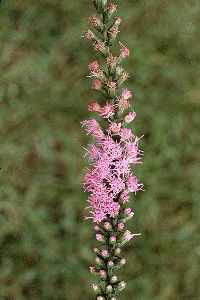
 As gold, orange and red leaves signal the approach of fall, so too, the purple and yellow fields of wildflowers tell us that summer is coming to an end. The colorful flower-heads of Liatris compliment the goldenrod and the slender-leaved sunflowers.
As gold, orange and red leaves signal the approach of fall, so too, the purple and yellow fields of wildflowers tell us that summer is coming to an end. The colorful flower-heads of Liatris compliment the goldenrod and the slender-leaved sunflowers.Liatris, called Blazing Star or Gay Feather, is a common plant and can be found growing in dry or damp places, uncultivated fields, thin woods, or sunny locations. The brilliant rose-purple heads are borne in spikes or spike-like racemes, some of which are two feet in length. The small fuzzy blossoms open at the top of the plant's spike rather than in the normal bottom-to-top sequence of other plants.
This genus of erect simple-stemmed perennials grows from a tuberous underground base. The leaves are alternate and unnotched, usually crowded on the stem and decreasing in size upwards. Liatris flower-heads are thistle-like, each composed of many tubular disc flowers emerging from a base of overlapping bracts. (The shape of these bracts is a help in identifying species.) As the flower-heads begin to make seeds, they put forth a growth called the pappus, made up of long, feathery bristles atop the one-seeded fruits. Liatris is hardy and easy to cultivate. Lean soils or moderately fertile soils encourage the best flowers with the straightest stalks. Full sun all day and fairly lean soil will encourage straight flower spikes and abundant bloom.
If the plant is moved during the growing season, the flower stalk should be cut off, leaving some of the leafy stem. The top may die, but it will usually appear the next spring. Seeds are slow to germinate, usually waiting until the second year.
Liatris is one of the most striking flowers that can be combined with the yellows and golds of the late fall garden.
